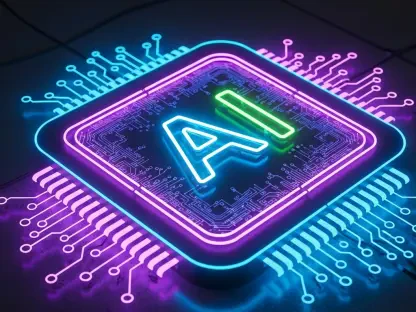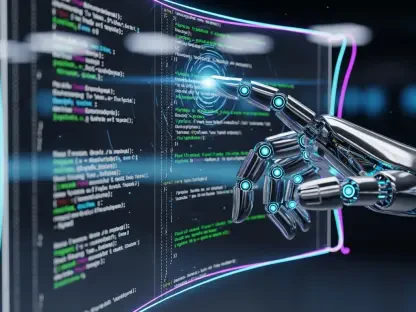Overview of AI-Driven Software Development
In the rapidly evolving world of software development, artificial intelligence has emerged as a transformative force, with large language models (LLMs) generating code at an unprecedented pace and scale, revolutionizing how developers approach their craft. These AI tools, capable of producing complex scripts in mere seconds, have become indispensable for accelerating project timelines and reducing manual coding efforts. Major players like Sonar have carved out a significant presence in this space, offering platforms that support millions of developers across diverse industries, from fintech to healthcare, in adopting AI solutions.
The adoption of AI-driven coding tools is not merely a trend but a fundamental shift, with organizations leveraging these technologies to stay competitive in a digital-first economy. This surge in usage, however, brings to light critical challenges, particularly around the quality of AI-generated code, which often inherits flaws from imperfect training datasets. Services like SonarSweep are stepping in to address these gaps, ensuring that the promise of AI in development is matched by reliability and security.
In-Depth Analysis of SonarSweep’s Role and Impact
Core Features and Technological Innovations
SonarSweep, a pioneering service by Sonar, focuses on enhancing AI-generated code by refining the training datasets used for LLMs, thereby minimizing security vulnerabilities and bugs at the source. By systematically vetting and cleansing data, this tool ensures that AI models learn from high-quality inputs, which directly translates to better code output. This process is a game-changer in reducing the propagation of errors that often plague automated coding systems.
Beyond data refinement, SonarSweep facilitates the retraining of AI models through reinforcement learning, adapting them to produce cleaner, more secure code over time. This iterative improvement leverages Sonar’s robust platform, which already supports over 35 programming languages and analyzes a staggering 750 billion lines of code daily. Such extensive capabilities provide a strong foundation for addressing the nuanced demands of modern software development.
Tangible Benefits and Performance Metrics
The impact of SonarSweep is evident in compelling data points, with reports indicating a potential reduction in cybersecurity vulnerabilities by up to 67% and bugs by 42%, as noted by Sonar’s Chief Growth Officer. These figures highlight the service’s capacity to fortify code against common threats, offering peace of mind to organizations reliant on AI tools. This improvement is not just about numbers but about fundamentally enhancing trust in automated systems.
Additionally, SonarSweep promotes cost efficiency by enabling the use of earlier, simpler LLMs instead of newer, resource-intensive models like ChatGPT 5. This strategic choice helps organizations save on operational expenses while still achieving high-quality outputs. For DevSecOps teams, this translates to lighter remediation workloads and smoother deployment workflows, allowing focus on innovation rather than constant firefighting.
Addressing Persistent Challenges in AI Code Quality
The road to consistent AI-generated code quality is fraught with obstacles, chief among them being the replication of flaws embedded in original training data. These inherited errors can compromise security and functionality, posing significant risks to applications in production. As AI tools churn out vast volumes of code, the scale of potential issues grows, often overwhelming development teams tasked with manual reviews.
This deluge of code creates a pressing need for automated quality control mechanisms, and SonarSweep stands out as a vital solution in this context. By preemptively tackling data quality, it reduces the downstream burden of fixing flawed outputs. Such automation is essential for scaling AI adoption without sacrificing the integrity of software products.
Moreover, strategic approaches beyond tools are necessary, including fostering a culture of continuous monitoring and integrating quality checks into every stage of the development lifecycle. Combining these practices with advanced services like SonarSweep can create a robust defense against the inherent variability of AI-generated code, ensuring that speed does not come at the expense of standards.
Navigating Regulatory and Compliance Frameworks
The regulatory landscape for AI-generated code is becoming increasingly stringent, with a sharp focus on security and data privacy standards that organizations must meet to avoid legal and reputational repercussions. Ensuring compliance is not just about checking boxes but about safeguarding user trust in an era where data breaches are all too common. Tools like SonarSweep play a pivotal role by embedding compliance-friendly practices into the code generation process.
Sonar’s established credibility, bolstered by partnerships with major clients such as Barclays and MasterCard, underscores its commitment to meeting industry benchmarks. This track record provides assurance that services like SonarSweep are designed with regulatory adherence in mind, helping organizations navigate complex requirements with confidence. Such alignment is crucial for secure and lawful code deployment across sectors.
Future Trends in AI Code Quality Solutions
Looking ahead, the evolution of AI coding tools promises further innovation, with services like SonarSweep poised to shape the trajectory of quality assurance in software development. Emerging trends point toward a growing interest in smaller, customized language models tailored for specific enterprise needs, offering precision over the broad capabilities of foundational LLMs. This shift reflects a desire for more controlled, efficient AI applications in niche domains.
Economic conditions and technological advancements will likely influence the balance between adopting comprehensive models and developing bespoke solutions. Enterprises with substantial resources may invest in custom models over the next few years, starting from this year to 2027, to gain a competitive edge through tailored outputs. Meanwhile, scalable tools like SonarSweep will continue to support a wider range of organizations seeking accessible quality enhancements.
The interplay of innovation and practicality will define the growth of AI code quality solutions, with an emphasis on integrating advanced tools into existing workflows. As challenges around data integrity and model complexity persist, the adaptability of platforms like SonarSweep will be key to ensuring that AI remains a reliable ally in software creation, fostering both efficiency and excellence.
Final Reflections and Strategic Recommendations
Reflecting on the insights gathered, it is clear that SonarSweep has addressed critical quality issues in AI-generated code, significantly bolstering security and reliability for countless organizations. Its ability to reduce vulnerabilities and bugs through refined data training has proven transformative, easing the strain on DevSecOps teams. The service’s foundation in Sonar’s extensive platform has further solidified its impact, ensuring scalability across diverse programming environments.
Looking back, the cost efficiencies achieved by leveraging simpler LLMs have offered a pragmatic approach, balancing innovation with fiscal responsibility. This strategic value has positioned SonarSweep as a cornerstone in the intersection of AI and DevOps, paving the way for more sustainable development practices. Its role in navigating regulatory landscapes has also been instrumental, providing a blueprint for compliance in an increasingly scrutinized field.
Moving forward, organizations should prioritize the adoption of quality assurance tools like SonarSweep to future-proof their AI integration strategies, focusing on seamless implementation and continuous improvement. Investing in training for teams to maximize these tools’ potential, alongside fostering partnerships with trusted providers, can amplify benefits. As the landscape evolves, staying proactive in embracing such solutions will be essential for maintaining a competitive edge and ensuring long-term success in software development.









